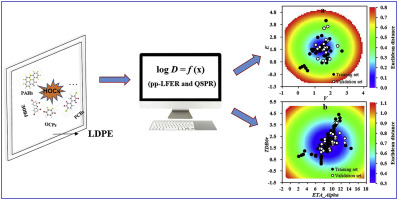当前位置:
X-MOL 学术
›
Ecotox. Environ. Saf.
›
论文详情
Our official English website, www.x-mol.net, welcomes your feedback! (Note: you will need to create a separate account there.)
Development of pp-LFER and QSPR models for predicting the diffusion coefficients of hydrophobic organic compounds in LDPE.
Ecotoxicology and Environmental Safety ( IF 6.8 ) Pub Date : 2020-01-08 , DOI: 10.1016/j.ecoenv.2020.110179 Tengyi Zhu 1 , Yue Jiang 1 , Haomiao Cheng 1 , Rajendra Prasad Singh 2 , Bipeng Yan 1
Ecotoxicology and Environmental Safety ( IF 6.8 ) Pub Date : 2020-01-08 , DOI: 10.1016/j.ecoenv.2020.110179 Tengyi Zhu 1 , Yue Jiang 1 , Haomiao Cheng 1 , Rajendra Prasad Singh 2 , Bipeng Yan 1
Affiliation

|
Diffusion coefficient (D) is important to evaluate the performance of passive samplers and to monitor the concentration of chemicals effectively. Herein, we developed a polyparameter linear free energy relationship (pp-LFER) model and a quantitative structure-property relationship (QSPR) model for the prediction of diffusion coefficients of hydrophobic organic contaminants (HOCs) in low density polyethylene (LDPE). A dataset of 120 various chemicals was used to develop both models. The pp-LFER model was developed with two descriptors (V and E) and the statistical parameters of the model showed satisfactory results. As a further exploration of the diffusion behavior of the compounds, a QSPR model with five descriptors (ETA_Alpha, ASP-6, IC1, TDB6r and ATSC2v) was constructed with adjusted determination coefficient (R2) of 0.949 and cross-validation coefficient (QLoo2) of 0.941. The regression results indicated that both models had satisfactory goodness-of-fit and robustness. This study proves that pp-LFER and QSPR approaches are available for the prediction of log D values for the hydrophobic organic compounds within the applicability domain.
中文翻译:

建立用于预测LDPE中疏水性有机化合物扩散系数的pp-LFER和QSPR模型。
扩散系数(D)对于评估被动采样器的性能并有效监控化学物质浓度非常重要。本文中,我们开发了用于预测低密度聚乙烯(LDPE)中疏水性有机污染物(HOCs)扩散系数的多参数线性自由能关系(pp-LFER)模型和定量结构-性质关系(QSPR)模型。使用120种各种化学物质的数据集来开发两个模型。用两个描述符(V和E)开发了pp-LFER模型,该模型的统计参数显示出令人满意的结果。为了进一步探索化合物的扩散行为,构建了具有五个描述符(ETA_Alpha,ASP-6,IC1,TDB6r和ATSC2v)的QSPR模型,调整后的测定系数(R2)为0。949,交叉验证系数(QLoo2)为0.941。回归结果表明,两个模型均具有令人满意的拟合优度和鲁棒性。这项研究证明pp-LFER和QSPR方法可用于预测适用范围内的疏水性有机化合物的log D值。
更新日期:2020-01-08
中文翻译:

建立用于预测LDPE中疏水性有机化合物扩散系数的pp-LFER和QSPR模型。
扩散系数(D)对于评估被动采样器的性能并有效监控化学物质浓度非常重要。本文中,我们开发了用于预测低密度聚乙烯(LDPE)中疏水性有机污染物(HOCs)扩散系数的多参数线性自由能关系(pp-LFER)模型和定量结构-性质关系(QSPR)模型。使用120种各种化学物质的数据集来开发两个模型。用两个描述符(V和E)开发了pp-LFER模型,该模型的统计参数显示出令人满意的结果。为了进一步探索化合物的扩散行为,构建了具有五个描述符(ETA_Alpha,ASP-6,IC1,TDB6r和ATSC2v)的QSPR模型,调整后的测定系数(R2)为0。949,交叉验证系数(QLoo2)为0.941。回归结果表明,两个模型均具有令人满意的拟合优度和鲁棒性。这项研究证明pp-LFER和QSPR方法可用于预测适用范围内的疏水性有机化合物的log D值。


























 京公网安备 11010802027423号
京公网安备 11010802027423号